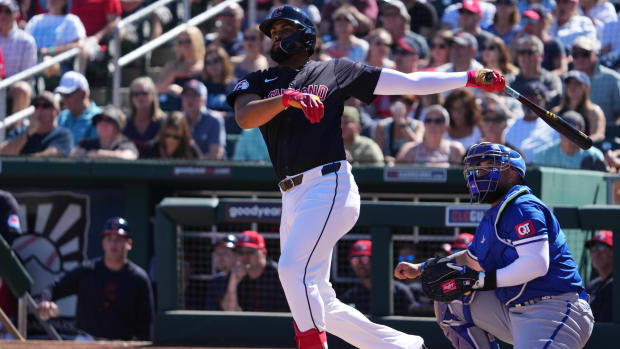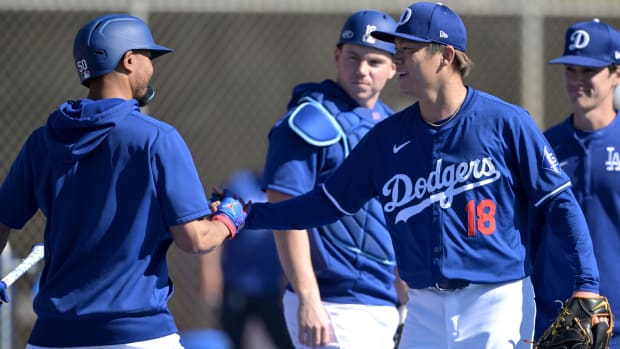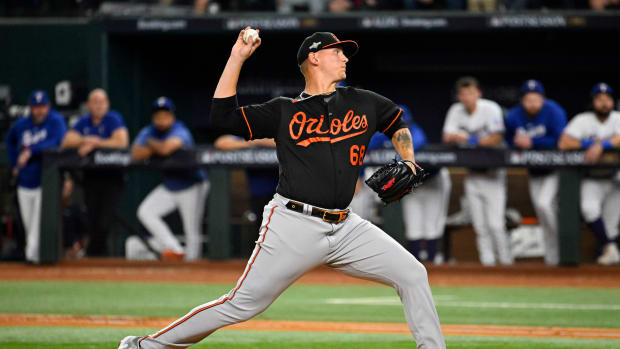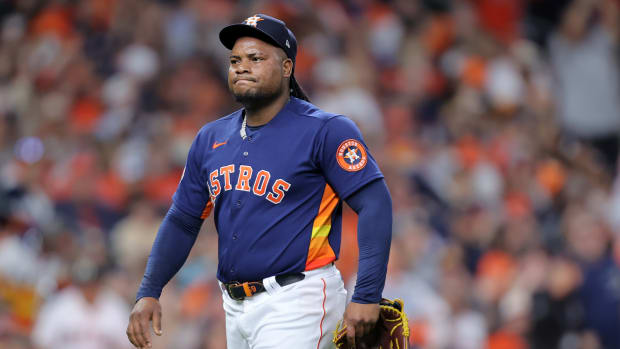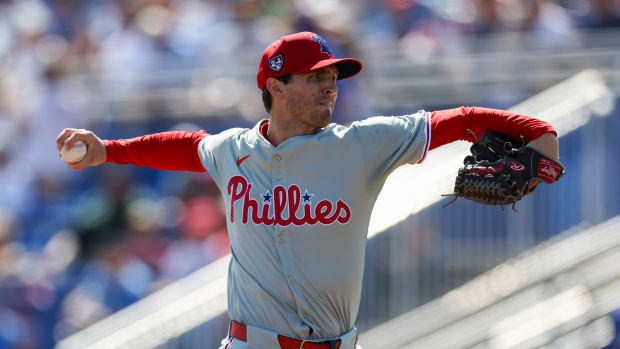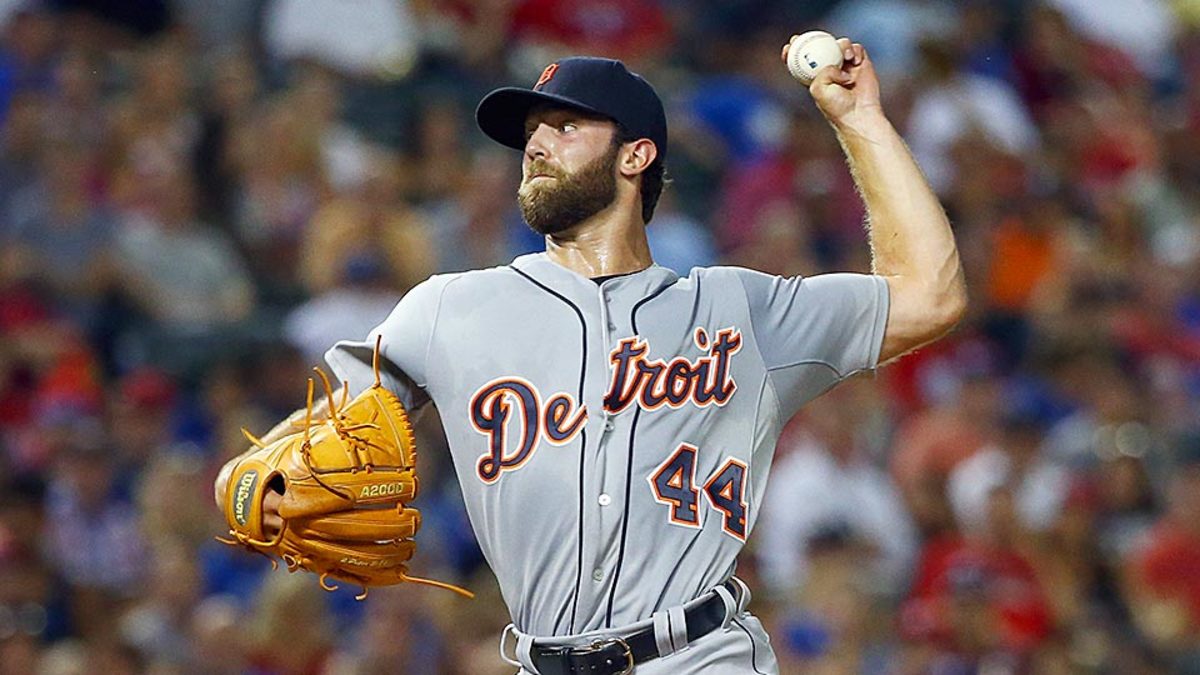
Ausmus rolls dice by overworking top prospect Norris in 54-pitch inning
How many pitches is too many for a pitcher to throw in one inning? How about for a 22-year-old–blue-chip prospect who was the top prize your organization acquired at the trading deadline? Thirty? Forty? How about 54? That’s how many pitches Tigers manager Brad Ausmus let Daniel Norris throw in the first inning of Tuesday night’s 7–6 loss to the Rangers, a pitch total matching the most thrown in a single inning by any pitcher in the last eight years. No one knows the correct answer to the question asked above, but it’s difficult to argue that Ausmus, whom it was just announced on Saturday will indeed return as the Tigers’ manager next season, wasn’t reckless with one of his team's most valuable assets.
Norris, who was rated the 18th-best prospect in baseball coming into the season and was the primary piece the Tigers received from the Blue Jays for David Price at the deadline, was making just his third start since returning from the disabled list due to a strained oblique on Sept. 16. In his first start back, he threw a total of 47 pitches in 3 2/3 innings. In his second, he threw 63 over five innings and became just the third starting pitcher in the last 100 years* to be removed from a game after five or more perfect innings, ironically getting the hook due to his pitch count. On Tuesday night, he threw 54 in the first inning alone.
*Eccentric Astros lefty Bob Knepper was removed after five perfect innings on Oct. 5, 1986 in what was effectively a warm-up start for the postseason in the NL West champion Astros' final game of the regular season. Knepper pitched well against the Mets in that year’s NLCS, but the Astros lost both games he started. Padres righty Andy Benes was pinch-hit for after six perfect innings on Aug. 3, 1991 because his manager, Greg Riddoch, wanted to limit him to six innings after he had been hit with two line drives in his previous start. The Padres were leading 1–0 with one out and runners on first and second when pinch-hitter Craig Shipley was sent up for Benes; Shipley hit into a double play.
This wasn’t an isolated incident. Since 2009, a pitcher has thrown 50 or more pitches in a single inning just 18 times. Only four teams, including the Tigers, have allowed that to happen twice over that span, and only three managers, including Ausmus, have allowed it to happen twice. None of those other teams (the Cardinals, Royals and Pirates) or other managers (Kansas City’s Ned Yost and former Pittsburgh skipper John Russell) allowed it to happen more than twice over that seven-year span. Ausmus has now allowed it to happen three times this season alone and four times in his two years at the helm in Detroit, good for 22% of those total instances in the past seven years.
pitcher | date | team | inning | manager | pitches |
Daniel Norris | Sept. 29, 2015 | Tigers | 1 | Brad Ausmus | 54 |
Paul Maholm | May 9, 2010 | Pirates | 3 | John Russell | 54 |
June 29, 2013 | Royals | 1 | Ned Yost | 53 | |
Dave Davidson | May 22, 2009 | 3 | Fredi Gonzalez | 52 | |
David Price | April 22, 2015 | Tigers | 1 | Brad Ausmus | 51 |
June 17, 2014 | Tigers | 2 | Brad Ausmus | 51 | |
June 28, 2013 | Cardinals | 2 | Mike Matheny | 51 | |
Erik Bedard | Sept. 20, 2011 | 3 | Terry Francona | 51 | |
John Danks | May 29, 2011 | 1 | Ozzie Guillen | 51 | |
Casey Coleman | April 22, 2011 | 3 | Mike Quade | 51 | |
Mike Pelfrey | July 19, 2010 | 1 | Jerry Manuel | 51 | |
Randy Wolf | Sept. 13, 2015 | Tigers | 1 | Brad Ausmus | 50 |
James Shields | April 12, 2014 | Royals | 2 | Ned Yost | 50 |
June 6, 2013 | D-Backs | 4 | Kirk Gibson | 50 | |
Kyle Kendrick | Aug. 8, 2012 | 2 | Charlie Manuel | 50 | |
Zach McAllister | Aug. 6, 2012 | Indians | 2 | Manny Acta | 50 |
Jaime Garcia | May 28, 2011 | Cardinals | 1 | Tony La Russa | 50 |
Ian Snell | June 23, 2009 | Pirates | 3 | John Russell | 50 |
Data courtesy Harry Pavlidis, Baseball Prospectus
Alarming as that might be, Ausmus’s prior violations were at least somewhat excusable in that they all involved veteran pitchers who were unlikely to remain with Detroit beyond the season at hand. Max Scherzer threw 51 pitches under Ausmus in a start last June, Price threw 51 under Ausmus in a start this April, and 39-year-old dumpster-dive pickup Randy Wolf threw 50 for Ausmus earlier this month. The Wolf game is fully excusable: It came in the second game of a doubleheader in Cleveland with a pitcher whose every pitch may be his last in the majors simply due to his age and decreased effectiveness, and getting Wolf through his 50-pitch first inning allowed him to work two more frames in a game the Tigers came back to win 9–2.
Three Strikes: The myth of October momentum; more thoughts
The Scherzer and Price games were more troubling. The Tigers may have already known by last June that Scherzer was going to depart when he hit free agency in November, but they still needed him to contend that season. There was no good reason to keep him in that game against the Royals after he had given up six runs without getting an out in the second inning, had runners on the corners and had thrown 37 pitches. Still, Ausmus not only left him in to get out of that inning (which he did, allowing one more run in the process), but let him pitch into the fifth in a game Detroit was losing 7–2.
As for Price, he got a pair of strikeouts early in his 51-pitch first inning against the Yankees on April 22, making it more understandable that Ausmus left his ace in the game to get that final out. Still, it was just Price’s third start of the season. The Tigers were 11–3 entering that game, looking to all the world like contenders one again. Regardless of the team’s hopes or lack thereof of re-signing Price, who like Scherzer the previous year was in his walk year, there was no good reason to push such a valuable arm so early in the season. Price’s 42nd pitch in that game was hit for a bases-clearing three-run double by journeyman Gregorio Petit, putting Detroit in a 5–0 hole. That would have been a good time to remove Price from the game. Instead, Price threw 51 pitches in that inning and pitched into the third in a game that Detroit lost 13–4.
• MLB playoff race: Full standings, postseason odds, magic numbers
Norris’s epic inning on Tuesday night was due in part to shoddy play from his defense. A ball that should have been an easy 4–3 putout shot under Ian Kinsler’s glove to start things off, and first baseman Jefry Marte completely misjudged a pop-up in fair territory four batters later. After the latter error, Norris got a groundout and a fly out, effectively getting four of the first seven batters he faced to hit balls that should have been outs. However, Norris also gave up a home run, walked a man, uncorked a wild pitch and endured a 10-pitch at-bat against Mike Napoli (ending in the misjudged pop-up). When Rougned Odor hit a triple on Norris’s 46th pitch after a seven-pitch at-bat of his own to drive in the fifth run of the inning, Norris should have been sent to the showers. Instead, he was not only left in the game, but was also brought back out to pitch the second inning as well. He threw 17 more pitches then was bizarrely pulled after recording the second out of the inning, quite possibly because, at 71 pitches, he hit his limit for the game—an irony if there ever were one.
National disgrace: Washington has serious issues to address, and soon
Of the 18 pitchers who have thrown 50 or more pitches in an inning over the last seven seasons, only one was as young as Norris, though interestingly, he was as highly regarded as a prospect. That was Shelby Miller, who threw 51 pitches in the second inning of the Cardinals’ 6–1 loss to the A’s on June 27, 2013. Miller had pitched a 1-2-3 first inning in that game and got two outs around three hits and two runs to start the second, but he just couldn’t get out of the inning. After the second out, he went to a full count on each of the next three batters, throwing 21 pitches and giving up two walks and a two-RBI single. He then got ahead of Jed Lowrie 1–2, only to give up an RBI double. And what happened next? Miller was removed from the game. Belatedly, yes, but after being pushed to the limit, Miller wasn’t asked to continue pitching, unlike all four of the pitchers Ausmus has pushed to the 50-pitch mark in a single inning.
This may be a lot of handwringing over nothing. Miller posted a 3.39 ERA over the remainder of the 2013 season and hasn’t missed a start since that 51-pitch inning, rebounding from a disappointing ’14 season with a strong, if historically unlucky, performance for the Braves this year, making the All-Star team and posting a 122 ERA+. Scherzer and Price have continued to be among the best pitchers in the game, both generating Cy Young talk at different points in the current season. The other pitchers on the list are more of a mixed bag, but any randomly selected group of major-league pitchers is going to contain its share of ghosts and cautionary tales.
• BRADLEY: Cal Ripken Jr. not resting on laurels in retirement
Still, given the association made between pitching arm injuries and pitches thrown while fatigued in studies such as those by former Baseball Prospectus analyst and current Indians director of baseball analytics Keith Woolner, it made very little sense to take the chance that Ausmus did on Tuesday with as valuable a young arm as Norris’s. Pitch count data goes back to 1988, and since then, the most pitches thrown in a single inning was the 62 thrown by Russ Ortiz under the watch of notorious pitcher-abuser Dusty Baker on July 26, 1999. Brad Ausmus let his organization’s top prospect come within eight of that total in the first inning Tuesday night, two starts removed from a disabled-list stay.
Maybe Norris will be as unaffected as Miller appears to have been by his lengthy outing two years ago. But if he gets hurt, or if his velocity and effectiveness fade next year, there will be many fingers pointing to Tuesday night’s 54 pitches and the manager who let him throw them.






























